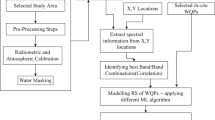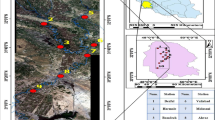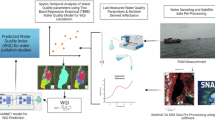Abstract
Recently, remote sensing considered as important tool in studies of water quality issues. The Aras River flows across a transboundary basin in northern Iran. In this study, the aim is to model the water quality parameters (WQPs) using remote sensing and an artificial neural network (ANN), which is a new method proposed to find WQPs based on multivariate regression approaches. The relationship between WQPs and digital data from the Sentinel-2 satellite was determined to estimate and map the WQPs in this river. Using the field data and digital image data, the obtained results show that multivariate regression approaches and high-resolution remote sensing could monitor and predict the distribution of WQPs in this basin. There was a meaningful correlation between bands calculated from image data and the river’s WQPs, including electrical conductivity (EC) (R2 = 0.91), Na+ (R2 = 0.81), Mg2+ (R2 = 0.90), SO42− (R2 = 0.89), Cl− (R2 = 0.81), and Ca2+ concentrations (R2 = 0.60). Likewise, the WQPs including EC, SO42−, Mg2+, and Cl− in the river are predicted using ANN. This powerful model is built for the rapid assessment and forecasting of experimentally mentioned WQPs at any location in the domain of interest. The results represent the good ability of ANN to simulate the mentioned WQPs. Simulation accuracy, measured by the determination coefficient (DC), varies between 0.982 and 0. 991 for training and overfitting EC test data. It is concluded that the management of transboundary rivers can be achieved by using remote sensing techniques and machine learning methods, which help the beneficiary countries in the sustainable operation.







Similar content being viewed by others
References
Aazami J, Taban P (2018) Monitoring of heavy metals in water, sediment and phragmites Australis of aras river along the Iranian-armenian border’’. Iran J Toxicol. 12(2):1–6. https://doi.org/10.29252/arakmu.12.2.1
Armenia: Strategic Mineral Sector. Sustainability Assessment. (2016) Swedish Geological ABin association with. SLR Consultants Ltd. AVAG Solutions Ltd. AUA Center. The World Bank. https://documents1.worldbank.org/curated/en/289051468186845846/pdf/106237-WP-P155900-PUBLIC.pdf
Boutra B, Sebti A, Trari M (2022) Response surface methodology and artificial neural network for optimization and modeling the photodegradation of organic pollutants in water. Int J Environ Sci Technol. https://doi.org/10.1007/s13762-021-03875-1
Campana ME, Vener BB, Lee BS (2012) Hydrostrategy, hydropolitics, and security in the kura-araks basin of the south caucasus. J Contemp Water Res Educ 149(1):22–32
Dehghani A, Roohi Aminjan A, Dehghani A (2022) Trophic transfer, bioaccumulation, and health risk assessment of heavy metals in Aras River: case study-Amphipoda-zander-human. Environ Sci Pollut Res Int. https://doi.org/10.1007/s11356-021-18036-7
Ekercin S (2007) Water quality retrievals from high resolution Ikonos multispectral imagery: a case study in Istanbul. Turk Water Air Soil Pollut 183(1):239–251. https://doi.org/10.1007/s11270-007-9373-5
Emamgholizadeh S, Kashi H, Marofpoor I et al (2014) Prediction of water quality parameters of Karoon River (Iran) by artificial intelligence-based models. Int J Environ Sci Technol 11:645–656. https://doi.org/10.1007/s13762-013-0378-x
Gabrielyan AV, Shahnazaryan GA, Minasyan SH (2018) Distribution and identification of sources of heavy metals in the Voghji river basin impacted by mining activities (Armenia). J Chem. https://doi.org/10.1155/2018/7172426
Gao Y, Gao J, Yin H, Liu C, Xia T, Wang J, Huang Q (2015) Remote sensing estimation of the total phosphorus concentration in a large lake using band combinations and regional multivariate statistical modeling techniques. J Environ Manag 151:33–43. https://doi.org/10.1016/j.jenvman.2014.11.036
González-Márquez LC, Torres-Bejarano FM, Rodríguez-Cuevas C et al (2018) Estimation of water quality parameters using Landsat 8 images: application to Playa Colorada Bay, Sinaloa, Mexico. Appl Geomat 10:147–158. https://doi.org/10.1007/s12518-018-0211-9
Hough I, Just AC, Zhou B, Dorman M, Lepeule J, Kloog I (2020) A multi-resolution air temperature model for France from MODIS and Landsat thermal data. Environ Res.183:109244. doi:https://doi.org/10.1016/j.envres.2020.109244. https://www.presstv.ir/Detail/2020/09/28/635185/Nagorno-Karabakh-Azerbaijan-Armenia-escalation-fighting
Karaoui I et al (2019) Evaluating the potential of Sentinel-2 satellite images for water quality characterization of artificial reservoirs: the Bin El Ouidane reservoir case study (morocco). Meteorol Hydrol Water Manag 7(1):31–39
Kumar P, Lai SH, Wong JK, Mohd NS, Kamal MR, Afan HA, Ahmed AN, Sherif M, Sefelnasr A, El-Shafie A (2020) Review of nitrogen compounds prediction in water bodies using artificial neural networks and other models. Sustainability 12:4359. https://doi.org/10.3390/su12114359
Li X, Li L, Liu X (2019) Collaborative inversion heavy metal stress in rice by using two-dimensional spectral feature space based on HJ-1 A HSI and radarsat-2 SAR remote sensing data. Int J Appl Earth Obs Geoinform 78:39–52. https://doi.org/10.1016/j.jag.2018.12.011
Ling F, Foody GM, Du H, Ban X, Li X, Zhang Y, Du Y (2017) Monitoring thermal pollution in rivers downstream of dams with Landsat ETM+ thermal infrared images. Remote Sens 9:1175. https://doi.org/10.3390/rs9111175
Ling Z, Sun D, Wang S et al (2020) Remote sensing estimation of colored dissolved organic matter (CDOM) from GOCI measurements in the Bohai Sea and Yellow Sea. Environ Sci Pollut Res 27:6872–6885. https://doi.org/10.1007/s11356-019-07435-6
Liu L-W, Wang Y-M (2019) Modelling reservoir turbidity using Landsat 8 satellite imagery by gene expression programming. Water 11:1479. https://doi.org/10.3390/w11071479
Liu H, Jiang Y, Misa R et al (2021) Ecological environment changes of mining areas around Nansi lake with remote sensing monitoring. Environ Sci Pollut Res. https://doi.org/10.1007/s11356-021-13849-y
Lu H, Li H, Liu T, Fan Y, Yuan Y, Xie M, Qian X (2019) Simulating heavy metal concentrations in an aquatic environment using artificial intelligence models and physicochemical indexes. Sci Total Environ 694:133591. https://doi.org/10.1016/j.scitotenv.2019.133591
Mahato JK, Gupta SK (2021) Exploring applicability of artificial intelligence and multivariate linear regression model for prediction of trihalomethanes in drinking water. Int J Environ Sci Technol. https://doi.org/10.1007/s13762-021-03392-1
Maillard P, Santos NAP (2008) A spatial-statistical approach for modeling the effect of non-point source pollution on different water quality parameters in the Velhas river watershed–Brazil. J Environ Manag 86(1):158–170. https://doi.org/10.1016/j.jenvman.2006.12.009
McCulloch WS, Pitts W (1943) A logical calculus of the ideas immanent in nervous activity. Bull Math Biophys 5:115–133. https://doi.org/10.1007/BF02478259
Miao S, Liu C, Qian B et al (2020) Remote sensing-based water quality assessment for urban rivers: a study in linyi development area. Environ Sci Pollut Res 27:34586–34595. https://doi.org/10.1007/s11356-018-4038-z
Najafi H, Nourani V, Sharghi E, Roushangar K, Dąbrowska D (2022) Application of Z-numbers to teleconnection modeling between monthly precipitation and large scale sea surface temperature. Hydrol Res 53(1):1–13. https://doi.org/10.2166/nh.2021.025
Nasehi F, Hassani A, Monavvari M, Karbassi A, Khorasani N, Imani A (2012) Heavy metal distributions in water of the Aras River Ardabil, Iran. J Water Resour Prot 4(2):73–78. https://doi.org/10.4236/jwarp.2012.42009
Nourani V, Kisi Ö, Komasi M (2011) Two hybrid artificial intelligence approaches for modeling rainfall–runoff process. J Hydrol 402:41–59. https://doi.org/10.1016/j.jhydrol.2011.03.002
Nourani V, Molajou A, Najafi H, Danandeh Mehr A (2019) Emotional ANN (EANN): a new generation of neural networks for hydrological modeling in IoT. In: Al-Turjman F (ed) Artificial intelligence in IoT. Springer, Cham, pp 45–61
Nourani V, Najafi H, Sharghi E, Roushangar K (2021) Application of Z-numbers to monitor drought using large-scale oceanic-atmospheric parameters. J Hydrol 598:126198. https://doi.org/10.1016/j.jhydrol.2021.126198
Palani S, Liong S-Y, Tkalich P (2008) An ANN application for water quality forecasting. Mar Pollut Bull 56(9):1586–1597. https://doi.org/10.1016/j.marpolbul.2008.05.021
Petus C, Waterhouse J, Lewis S, Vacher M, Tracey D, Devlin M (2019) A flood of information: using Sentinel-3 water colour products to assure continuity in the monitoring of water quality trends in the Great Barrier Reef (Australia). J Environ Manag 248:109255. https://doi.org/10.1016/j.jenvman.2019.07.026
Ritchie JC, Zimba PV, Everitt JH (2003) Remote sensing techniques to assess water quality. J Photogramm Eng Remote Sens 69(6):695–704. https://doi.org/10.14358/PERS.69.6.695
Seo I, Yun S, Choi S (2016) Forecasting water quality parameters by ann model using pre-processing technique at the downstream of cheongpyeong dam. Procedia Eng. https://doi.org/10.1016/j.proeng.2016.07.519
Shareef MA, Toumi A, Khenchaf A (2014) Prediction of water quality parameters from SAR images by using multivariate and texture analysis models. SAR Image Anal Model Techn XIV SPIE 9243:363–378. https://doi.org/10.1117/12.2067262
Sharghi E, Nourani V, Najafi H et al (2018) Emotional ANN (EANN) and wavelet-ANN (WANN) approaches for Markovian and seasonal based modeling of rainfall-runoff process. Water Resour Manage 32:3441–3456. https://doi.org/10.1007/s11269-018-2000-y
Sharghi E, Paknezhad NJ, Najafi H (2021) Assessing the effect of emotional unit of emotional ANN (EANN) in estimation of the prediction intervals of suspended sediment load modeling. Earth Sci Inf 14(1):201–213. https://doi.org/10.1007/s12145-020-00567-1
Singh S, Bhardwaj A, Verma VK (2020) Remote sensing and GIS based analysis of temporal land use/land cover and water quality changes in Harike wetland ecosystem, Punjab, India. J Environ Manag 262:110355. https://doi.org/10.1016/j.jenvman.2020.110355
Suleymanov B, Ahmedov M, Safarova K, Steinnes E (2010) Metals in main rivers of Azerbaijan: influence of transboundary pollution. Water Air Soil Pollut 213:301–310. https://doi.org/10.1007/s11270-010-0385-1
Swain R, Sahoo B (2017) Mapping of heavy metal pollution in river water at daily time-scale using spatio-temporal fusion of MODIS-aqua and Landsat satellite imageries. J Environ Manag 192:1–14. https://doi.org/10.1016/j.jenvman.2017.01.034
Toming K, Kutser T, Laas A, Sepp M, Paavel B, Nõges T (2006) First experiences in mapping lakewater quality parameters with sentinel-2 MSI imagery. Remote Sens 8(8):640. https://doi.org/10.3390/rs8080640
Torres-Bejarano F, Arteaga-Hernández F, Rodríguez-Ibarra D, González-Márquez LC (2021) Water quality assessment in a wetland complex using Sentinel 2 satellite images. Int J Environ Sci Technol 18:2345–2356. https://doi.org/10.1007/s13762-020-02988-3
Vignolo A, Pochettino A, Cicerone D (2006) Water quality assessment using remote sensing techniques: Medrano Creek. Argent J Environ Manag 81(4):429–433
Zamani A, Azimian A, Heemink A, Solomatine D (2009) Wave height prediction at the caspian Sea using a data-driven model and ensemble-based data assimilation methods. J Hydroinform 11(2):154–164. https://doi.org/10.2166/hydro.2009.043
Zhang Y, Pulliainen JT, Koponen SS, Hallikainen MT (2003) Water quality retrievals from combined Landsat TM data and ERS-2 SAR data in the Gulf of Finland. IEEE Trans Geosci Remote Sens 41(3):622–629. https://doi.org/10.1109/TGRS.2003.808906
Zhang Y, Fitch P, Vilas MP, Thorburn PJ (2019) Applying multi-layer artificial neural network and mutual information to the prediction of trends in dissolved oxygen. Front Environ Sci 7:46. https://doi.org/10.3389/fenvs.2019.00046
Acknowledgements
The authors would like to acknowledge Dr. Javad Parsa (University of Tabriz), for his useful suggestions to improve the quality of the research presented in this manuscript.
Funding
The authors have not disclosed any competing interests.
Author information
Authors and Affiliations
Contributions
Fouladi Osgouei, Zarghami contributed significantly to the conceptualization and methodology framework. HFO, performed the data analysis and interpretation. Fouladi Osgouei, Zarghami, Mosaferi, and Karimzadeh structured and professionally optimized the manuscript.
Corresponding author
Ethics declarations
Conflict of interests
The authors declare that they have no known competing financial interests or personal relationships that could have appeared to influence the work reported in this paper.
Additional information
Editorial responsibility: Maryam Shabani.
Rights and permissions
About this article
Cite this article
Fouladi Osgouei, H., Zarghami, M., Mosaferi, M. et al. A novel analysis of critical water pollution in the transboundary Aras River using the Sentinel-2 satellite images and ANNs. Int. J. Environ. Sci. Technol. 19, 9011–9026 (2022). https://doi.org/10.1007/s13762-022-04129-4
Received:
Revised:
Accepted:
Published:
Issue Date:
DOI: https://doi.org/10.1007/s13762-022-04129-4




